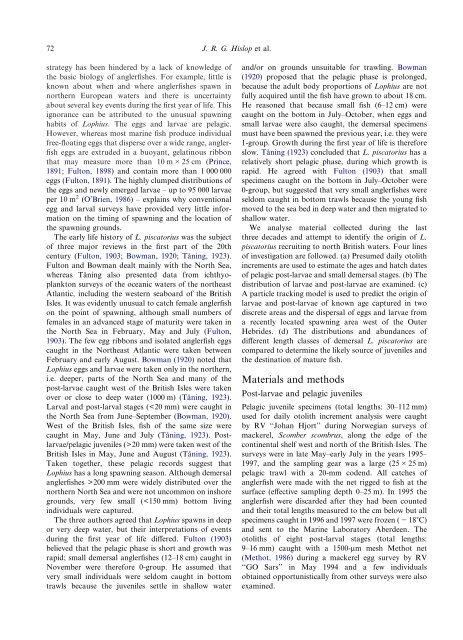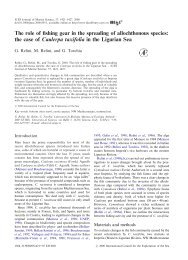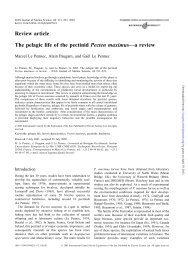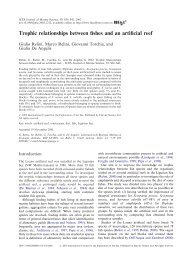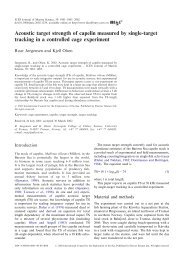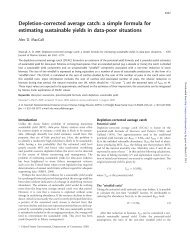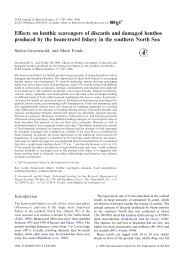A synthesis of the early life history of the anglerfish, Lophius ...
A synthesis of the early life history of the anglerfish, Lophius ...
A synthesis of the early life history of the anglerfish, Lophius ...
You also want an ePaper? Increase the reach of your titles
YUMPU automatically turns print PDFs into web optimized ePapers that Google loves.
72 J. R. G. Hislop et al.<br />
strategy has been hindered by a lack <strong>of</strong> knowledge <strong>of</strong><br />
<strong>the</strong> basic biology <strong>of</strong> <strong>anglerfish</strong>es. For example, little is<br />
known about when and where <strong>anglerfish</strong>es spawn in<br />
nor<strong>the</strong>rn European waters and <strong>the</strong>re is uncertainty<br />
about several key events during <strong>the</strong> first year <strong>of</strong> <strong>life</strong>. This<br />
ignorance can be attributed to <strong>the</strong> unusual spawning<br />
habits <strong>of</strong> <strong>Lophius</strong>. The eggs and larvae are pelagic.<br />
However, whereas most marine fish produce individual<br />
free-floating eggs that disperse over a wide range, <strong>anglerfish</strong><br />
eggs are extruded in a buoyant, gelatinous ribbon<br />
that may measure more than 10 m25 cm (Prince,<br />
1891; Fulton, 1898) and contain more than 1 000 000<br />
eggs (Fulton, 1891). The highly clumped distributions <strong>of</strong><br />
<strong>the</strong> eggs and newly emerged larvae – up to 95 000 larvae<br />
per 10 m 2 (O’Brien, 1986) – explains why conventional<br />
egg and larval surveys have provided very little information<br />
on <strong>the</strong> timing <strong>of</strong> spawning and <strong>the</strong> location <strong>of</strong><br />
<strong>the</strong> spawning grounds.<br />
The <strong>early</strong> <strong>life</strong> <strong>history</strong> <strong>of</strong> L. piscatorius was <strong>the</strong> subject<br />
<strong>of</strong> three major reviews in <strong>the</strong> first part <strong>of</strong> <strong>the</strong> 20th<br />
century (Fulton, 1903; Bowman, 1920; Tåning, 1923).<br />
Fulton and Bowman dealt mainly with <strong>the</strong> North Sea,<br />
whereas Tåning also presented data from ichthyoplankton<br />
surveys <strong>of</strong> <strong>the</strong> oceanic waters <strong>of</strong> <strong>the</strong> nor<strong>the</strong>ast<br />
Atlantic, including <strong>the</strong> western seaboard <strong>of</strong> <strong>the</strong> British<br />
Isles. It was evidently unusual to catch female <strong>anglerfish</strong><br />
on <strong>the</strong> point <strong>of</strong> spawning, although small numbers <strong>of</strong><br />
females in an advanced stage <strong>of</strong> maturity were taken in<br />
<strong>the</strong> North Sea in February, May and July (Fulton,<br />
1903). The few egg ribbons and isolated <strong>anglerfish</strong> eggs<br />
caught in <strong>the</strong> Nor<strong>the</strong>ast Atlantic were taken between<br />
February and <strong>early</strong> August. Bowman (1920) noted that<br />
<strong>Lophius</strong> eggs and larvae were taken only in <strong>the</strong> nor<strong>the</strong>rn,<br />
i.e. deeper, parts <strong>of</strong> <strong>the</strong> North Sea and many <strong>of</strong> <strong>the</strong><br />
post-larvae caught west <strong>of</strong> <strong>the</strong> British Isles were taken<br />
over or close to deep water (1000 m) (Tåning, 1923).<br />
Larval and post-larval stages (20 mm) were taken west <strong>of</strong> <strong>the</strong><br />
British Isles in May, June and August (Tåning, 1923).<br />
Taken toge<strong>the</strong>r, <strong>the</strong>se pelagic records suggest that<br />
<strong>Lophius</strong> has a long spawning season. Although demersal<br />
<strong>anglerfish</strong>es >200 mm were widely distributed over <strong>the</strong><br />
nor<strong>the</strong>rn North Sea and were not uncommon on inshore<br />
grounds, very few small (


